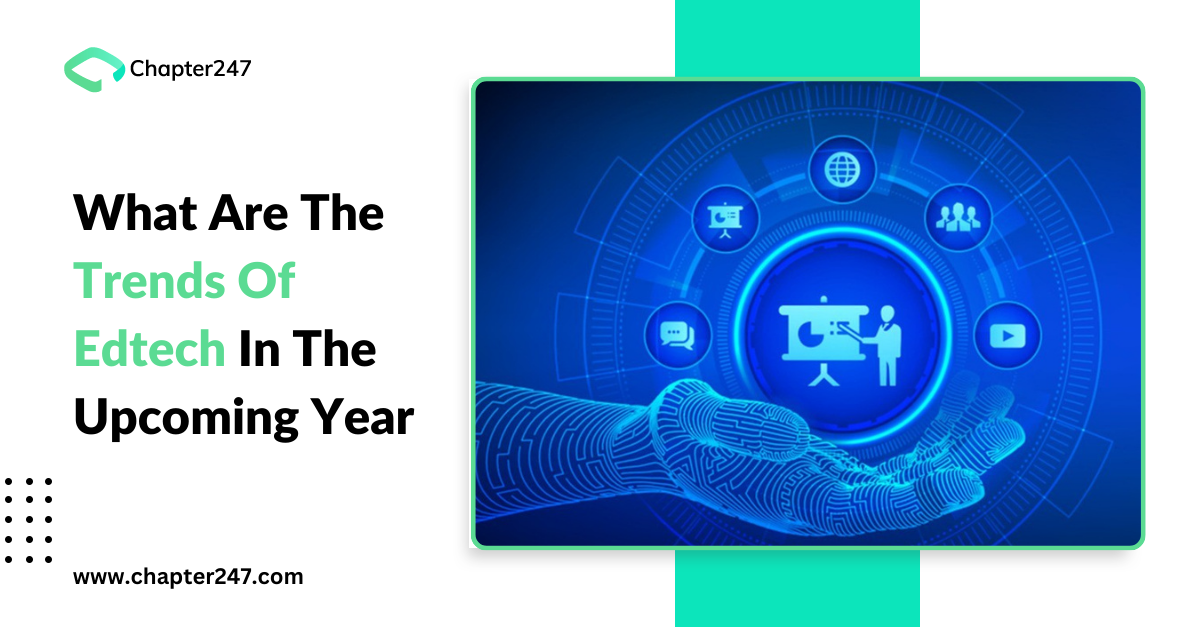Take off on a journey of learning! Exciting developments in EdTech are expected in the coming year, including personalized learning paths, immersive learning experiences, and cutting-edge tools that will transform education in the future. Let’s get going!
Table of Content
- Introduction
- What Was Happening In That Market From Past Days
- What Are The Technologies That Bringing The Trend In EdTech
- How The Industry Is Growing
- Cybersecurity And 5G Technology
- Final Thoughts
Introduction
The traditional educational landscape is changing due to the recent, unprecedented global education technology (EdTech) market surge. According to Statista, the EdTech market is expected to grow at a compound annual growth rate (CAGR) of 16.3% from 2021 to 2025, reaching an astounding $404 billion.
A number of factors have contributed to this explosive growth, including the global shift towards digital learning and the introduction of cutting-edge technologies that are changing the face of education.
What Was Happening In That Market From Past Days
It is essential to look at the history of the EdTech sector in order to comprehend its current situation. A major paradigm shift in education has occurred during the last ten years, characterized by a greater dependence on digital platforms.
This change was expedited by the COVID-19 pandemic, which forced colleges and universities worldwide to implement remote learning programs. This sparked the EdTech explosion as teachers and students looked for creative solutions to the difficulties brought on by the abrupt switch to virtual classrooms.
A number of sub-sectors, including gamified educational content, virtual tutoring, and online learning platforms, emerged in the EdTech market during this time. The need for individualized, flexible, and accessible learning experiences was tapped into by EdTech businesses. Consequently, the market not only made it through the pandemic but flourished, paving the way for future expansion.
What Are The Technologies That Bringing The Trend In EdTech
The current EdTech trend is being driven by a number of disruptive technologies that are changing how knowledge is taught and acquired:
- Machine learning (ML) and artificial intelligence (AI):
The use of AI in education is anticipated to increase at an astounding 18.3% CAGR between 2020 and 2025. The market for artificial intelligence in education is predicted to reach $10.7 billion by 2025, demonstrating the enormous potential for individualized and flexible learning, according to HononIQ, the source.
- Virtual reality (VR) and augmented reality (AR):
The augmented and virtual reality market in education is expected to grow significantly to $3.8 billion by 2027. With their realistic and interactive simulations, these immersive technologies are completely changing the way that students interact with instructional materials, according to Allied Market Research.
- The technology of Blockchain:
Blockchain is revolutionizing the way that credentials are verified in the educational field. Blockchain offers a decentralized solution to the certification process by ensuring the security and integrity of educational records through its transparent and tamper-proof nature.
- The creation of websites and applications:
The e-learning industry is growing rapidly worldwide and is expected to reach $375 billion in sales by 2026. The growth of learning platforms that are web- and app-based emphasizes the trend toward more digital and easily accessible learning materials.
- Mobile Education:
Mobile learning is becoming more and more common; by 2025, there will be 2.5 billion users worldwide. This figure illustrates how the demand for mobile learning experiences is rising, increasing the flexibility and accessibility of education (Source: eLearning Industry).
- The creation of websites and applications:
In the EdTech landscape, the creation of web and mobile applications is essential to enabling engaging and easy-to-use learning environments. The importance of app development in the tech-driven education sector is demonstrated by the projection that the global mobile app market revenue will reach $693 billion by 2025 (Source: Statista).
- Big Data Analysis:
Large-scale data collection and analysis are made possible by big data analytics, which helps to customize learning experiences further. Based on data-driven insights to improve educational outcomes, the global EdTech and smart classroom market size is anticipated to reach $181.3 billion by 2025, propelled by Big Data analytics (Source: MarketsandMarkets).
How The Industry Is Growing
A number of factors are coming together to drive the growth of the EdTech industry, such as increased internet penetration, a growing demand for skill-based learning, and increased awareness of the advantages of digital education. With 2.5 billion mobile learning users predicted by 2025, mobile learning is expected to become increasingly popular (Source: eLearning Industry).
Moreover, the adoption of EdTech solutions is being driven by the need for reskilling and upskilling in light of the quickly changing job markets. Professional development now revolves around lifelong learning, with businesses and individuals spending money on microlearning modules and online courses.
The adoption of EdTech solutions in traditional educational institutions was accelerated by the global pandemic. Schools and universities will probably continue to use blended learning, which combines traditional and digital teaching methods, even when they start offering in-person classes again. According to a UNESCO report, there has been a consistent commitment to digital education, as evidenced by the 73% of surveyed education ministries that viewed EdTech as a long-term strategy.
Cybersecurity and 5G Technology Integration
Safeguarding sensitive student data with strong cybersecurity measures becomes crucial in this quickly changing environment. By 2025, it is anticipated that global spending on cybersecurity in education will amount to $3.1 billion, reflecting the increasing awareness of the significance of data protection in the context of digital learning revealed by MarketsandMarkets.
Furthermore, the EdTech experience will be improved by the integration of 5G technology, which will offer faster and more dependable connectivity. Grand View Research projects that the global 5G market will reach $668.4 billion by 2026 and that it will have a revolutionary effect on the real-time delivery of educational content and collaborative learning experiences.
Final Thoughts
The EdTech industry portends more for the future of education than merely being a reaction to the present problems. The industry has experienced unparalleled growth due to the incorporation of cutting-edge technologies and a growing focus on customization and flexibility. It’s critical that educators, students, and legislators embrace EdTech’s potential to create a more open and productive learning environment as we traverse this digital frontier.
The data presents an impressive picture of the EdTech revolution, with predictions showing continued growth and innovation. But it’s imperative that we approach this change with caution, making sure that everyone benefits from technology and that no student is left behind. For more information, connect with Chapter247. We are ready to push your way of innovation with a touch of technology.








